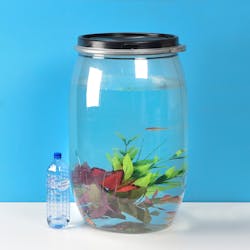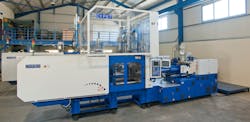ST BlowMoulding
ST BlowMoulding, Stabio, Switzerland, unveiled a three-layer, continuous extrusion blow molding machine designed to make 220-liter L-ring drums and open-head drums at speeds of up to 50 pieces per hour.
Dubbed the ECT 880 CoEx3, it was the biggest machine in K 2019’s blow molding hall, at about 32 feet long by 25 feet high. It ran with a mold owned by a German maker of industrial packaging that had bought the machine. After the show, ST planned to customize it for the company, with Managing Partner Martin Graziadei noting, “We don’t make standard machines.”
Compared to traditional accumulator-head blow molding machines, the ECT 880 CoEx3 delivers a 10 percent faster cycle time, more uniform wall thickness and significant energy savings, Graziadei said. The three-layer configuration allows each layer of HDPE to offer a specific feature, for example, a high-purity material in the inner layer, regrind in the middle layer and an antistatic additive in the outer layer for increased fire safety.
The inner and outer layers each constitute about 20 percent of the drum’s wall thickness, and the middle layer constitutes 60 percent. Managing Director Luca Moltrasio said that the middle layer can use about 25 percent industrial regrind.
ST also noted that the machine features specific devices to help ensure safe tooling changeovers, including an electric hoist to raise the core and die, an adjustable swivel arm to align them with the extrusion head and a movable catwalk protruding from the machine’s mezzanine to allow access under the extrusion head.
Graziadei said that the ECT 880 CoEx3, as configured at the show, would cost about $1.9 million.
Cypet Technologies
Cypet Technologies, Nicosia, Cyprus, showcased its upgraded technology for large PET containers, with an injection-stretch blow molding machine — the Cypet K 53 — producing 120-liter PET drums with a 15.7-inch neck diameter.
Director Constantinos Sideris said his company takes a different approach to single-stage blow molding, which conventionally uses a vertical clamp to injection mold the preforms and a horizontal clamp for blowing containers.
He said the upgraded machine is similar to the company’s previous technology, but Cypet has added temperature profiling of the preform between the injection and the blowing stages.
“This allows better control of the wall thickness distribution on the container, especially for large, heavy containers,” Sideris said. “Additionally, there has been a great deal of application development that enables unique and very large containers to be produced on Cypet machines, extending the applications for which PET can be used.”
Cypet’s machines mold preforms horizontally so that the opening direction of the mold is horizontal. “And we blow the bottles vertically so that again, the mold opening is horizontal,” he said. “This means that we can put the blow mold and injection mold on one and the same clamping unit, and we open and close both molds together. This is a substantial difference in the mechanics.”
The Cypet machine uses an injection molding frame. A special station transfers the preform to the blow molding area above. Sideris said that the firm’s patented production method has three main steps: transferring the preforms from the injection molds to the blow molds, stretch blow molding the preforms into containers and removing the containers from the blow molds.
“The stretch blowing happens in parallel with the injection molding of the next set of preforms,” Sideris said. “The injection mold has a design of a typical two-stage preform mold, with a valve-gated and naturally balanced hot runner.”
PET containers made by injection stretch blow molding traditionally are considered “large” when they can hold 10 to 30 liters. But the Cypet process is redefining what big means. The company already has commercialized machines that can make 50-liter containers for beer and milk.
A customer in Mexico used the machine to make a clear, 60-liter fruit and vegetable container, replacing an injection molded PP crate.
“One of the advantages of our machines,” Sideris said, “is that they are very flexible with respect to the range of sizes that can be produced on the same machine model, by simply changing molds. For example, on the Cypet K 53, one can produce 120-liter PET drums with [a one-cavity mold]; 25-liter stackable PET containers with two cavities; 10-liter bottles with six cavities, and 120mm-neck jars with eight cavities.”
At K 2019, Cypet displayed a clear, 120-liter drum. Sideris said a Dutch customer, which intends to use the drum to hold fish oil, is the first to buy its Cypet K 53 machine. He said that PET drums have the advantage of being 25 to 30 percent lighter than HDPE drums, with easy-to-clean surfaces.
Sideris said containers as large as 240 liters are on the horizon. The Cypet K 100, which can produce 220-liter PET drums, will be available for sale early this year. In the U.S., Applied Resources International represents Cypet.
Robert Grace, contributor
Applied Resources International LLC, Harlingen, Texas, 603-738-6800, www.appliedresourcesint.com
ST BlowMoulding SA, Stabio, Switzerland, 41-912-204-961, www.st-blowmoulding.com
About the Author
Robert Grace
Robert Grace is editor of The Journal of Blow Molding.


